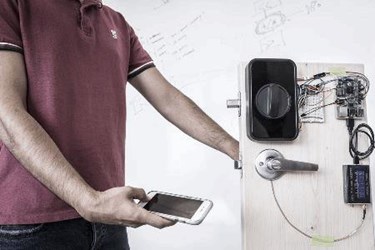Human Body As Conduit For Wireless Data Communication
By Jof Enriquez,
Follow me on Twitter @jofenriq

Researchers at the University of Washington (UW) have, for the first time, successfully demonstrated that commodity devices such as smartphones and laptops can transmit electromagnetic signals directly through the body, thereby offering a more secure alternative to over-the-air wireless technologies that are vulnerable to attacks.
"Smartphones and laptops currently rely on radios such as Bluetooth and Wi-Fi for communication. These radios are designed to do the opposite of restricting a transmission to the body, and hence are inherently insecure," the researchers wrote in a paper.
They are hardly the first to use the human body as a data conduit, but they claim to be the first to demonstrate it using commodity input devices, such as fingerprint sensors and touchpads that are that are common on smartphones and laptops.
In the paper, they explained how the inherent electrical properties of human tissue can effectively be taken advantage of to transmit and modulate electromagnetic signals less than 10 MHz emanating from iPhone fingerprint sensors and Lenovo laptop touchpads. As receivers for transmissions from these sensors, the researchers used their software defined radio (SDR).
"We show experimentally that these low frequency signals propagate well on the human body but degrade significantly over air, enabling our goal of secure on-body data transmissions," wrote the researchers.
Through experiments, they also found out that devices placed anywhere on the surface of the body can receive transmissions from fingerprint sensors and touchpads. Signal propagation across different body types and postures – when the subject is standing, seated, and lying down – showed minimal changes.
According to the UW group, this type of on-body communication provides a "physical layer security" that is currently non-existent on commodity devices. The technique could be used in many application scenarios, such as authenticating locks via touch.
"The primary use cases are where security is very valuable, such as unlocking a door,” said co-lead author Vikram Iyer, a doctoral student in the electrical engineering department, in a news release. “It has a [slow transmission rate] but it’d be a good replacement for anything that requires a four-digit code to unlock."
In their paper, the researchers described a door and doorknob with a built-in receiver and electronic lock. A signal carrying an authentication code is transmitted from a handheld smartphone's fingerprint sensor, through the body, to the doorknob when the person touches it, unlocking the door. In this system, no keycards, keypads, passwords, or biometric systems are required. The user needs only a smartphone or similar mobile device, paired with a wireless receiver to unlock the door.
Another application could be secure pairing of wearable medical devices, which are increasingly threatened by cybersecurity attacks.
"For instance, instead of manually typing in a secret serial number or password for wirelessly pairing medical devices such as glucose or blood pressure monitors with smartphones, a smartphone could directly transmit arbitrary secret keys through the human body," explained the researchers.
Improvements in the design of this on-body communication method – particularly the addition of a strong encryption protocol – could further expand described applications.
"Imagine if your phone or credit card could connect to a point of sale system and charge your card without you having to pull out your phone or wallet," Andrew McKenna, an Information School lecturer who specializes in information security, told UW’s The Daily. "Or if your grocery cart could track the items in the cart by touch. There are lots of cool uses."
